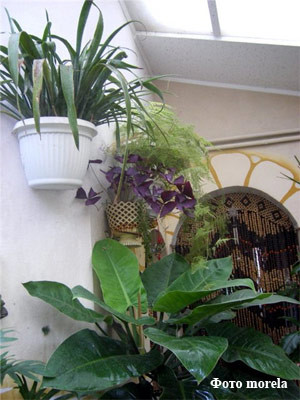 Покой растенийРазличают органический и forced dormancy. Organic dormancy does not involve a transition to an increasing growth form due to the special state of the plant. To change this state, the plant needs a certain time, temperature and lighting. Organic dormancy is due to the hereditary properties of plants that have developed in the process of evolution. Forced dormancy is caused by the absence of favorable conditions for growth. This is, first of all, a decrease in illumination in winter and a decrease in temperature. If there is enough light and heat, then forced dormancy does not occur. Indoor plants can be divided into three groups: 1. Plants that do not have a dormant period under favorable growth conditions (tradescantia, cyperus, clivia, ophiopogon, etc.). These plants can be kept in winter under normal conditions, but it should be taken into account that some loss of leaves and slower growth are natural with reduced illumination in winter. 2. Plants that have an obligatory dormant period during the year (orchids, gloxinia, caladium, some cacti, etc.). Plants of this group do not tolerate the absence of a dormant period well. They need it to form flower buds or for spring growth. Without a dormant period, some plants may simply die. 3. Plants for which a dormant state is not necessary, i.e. they may or may not have it. These plants can grow all year round (Amarellis, Crinums, etc.). The duration of the dormant period is influenced by various external factors: temperature, soil moisture, light intensity, etc. Low temperatures lengthen the dormant period, high temperatures shorten it. This is the basis for forcing plants. Dry soil lengthens the dormant period, moisture shortens it. Light also shortens the dormant period. Natural conditions are such that in winter, daylight hours are shortened so much that they are not enough for intensive growth, so most plants slow down their growth and are ready for a dormant period. The frequency of watering should be reduced, the room temperature should be lowered. Plants that have a mandatory dormant period (gloxinia, cyclamen, pomegranate, etc.) are best placed in a cool, dark basement, protected from drafts, but at the same time with enough fresh air. In city apartments, the best place to overwinter is the bathroom, directly under the bathtub. A sign of the end of the dormant period is the beginning of plant growth. If you put the pot with the gloxinia cut for the winter under the bathtub, then, looking there in the spring, you will find that shoots have appeared from the ground - it's time to take the flower out and place it in its usual place on the windowsill. Gradually resume the usual watering and feeding regime, if necessary, transplant the plant. Those plants that do not require a dormant period (violets, balsam, cyperus, etc.), however, need to be watered and fed less during the month when daylight hours are shortest. Winter-flowering potted plants that do not require a dormant period should be watered and fed regularly throughout the flowering period.
Покой растенийРазличают органический и forced dormancy. Organic dormancy does not involve a transition to an increasing growth form due to the special state of the plant. To change this state, the plant needs a certain time, temperature and lighting. Organic dormancy is due to the hereditary properties of plants that have developed in the process of evolution. Forced dormancy is caused by the absence of favorable conditions for growth. This is, first of all, a decrease in illumination in winter and a decrease in temperature. If there is enough light and heat, then forced dormancy does not occur. Indoor plants can be divided into three groups: 1. Plants that do not have a dormant period under favorable growth conditions (tradescantia, cyperus, clivia, ophiopogon, etc.). These plants can be kept in winter under normal conditions, but it should be taken into account that some loss of leaves and slower growth are natural with reduced illumination in winter. 2. Plants that have an obligatory dormant period during the year (orchids, gloxinia, caladium, some cacti, etc.). Plants of this group do not tolerate the absence of a dormant period well. They need it to form flower buds or for spring growth. Without a dormant period, some plants may simply die. 3. Plants for which a dormant state is not necessary, i.e. they may or may not have it. These plants can grow all year round (Amarellis, Crinums, etc.). The duration of the dormant period is influenced by various external factors: temperature, soil moisture, light intensity, etc. Low temperatures lengthen the dormant period, high temperatures shorten it. This is the basis for forcing plants. Dry soil lengthens the dormant period, moisture shortens it. Light also shortens the dormant period. Natural conditions are such that in winter, daylight hours are shortened so much that they are not enough for intensive growth, so most plants slow down their growth and are ready for a dormant period. The frequency of watering should be reduced, the room temperature should be lowered. Plants that have a mandatory dormant period (gloxinia, cyclamen, pomegranate, etc.) are best placed in a cool, dark basement, protected from drafts, but at the same time with enough fresh air. In city apartments, the best place to overwinter is the bathroom, directly under the bathtub. A sign of the end of the dormant period is the beginning of plant growth. If you put the pot with the gloxinia cut for the winter under the bathtub, then, looking there in the spring, you will find that shoots have appeared from the ground - it's time to take the flower out and place it in its usual place on the windowsill. Gradually resume the usual watering and feeding regime, if necessary, transplant the plant. Those plants that do not require a dormant period (violets, balsam, cyperus, etc.), however, need to be watered and fed less during the month when daylight hours are shortest. Winter-flowering potted plants that do not require a dormant period should be watered and fed regularly throughout the flowering period.
Important
For some reason, many people believe that the period of restis associated only with a decrease in temperature, and if the apartment is warm in winter, the plants do not rest. But in addition to temperature, there are also such factors as light, nutrition, etc. In fact, quite a lot of problems, diseases and even death of plants occur in the winter months, when there should be a forced or obligatory rest period. If you think about it, most plants die during the winter. Mainly due to violations of maintenance conditions - with a lack of light, not cool enough temperature, proximity to the heating system, too dry air, plants grow poorly and are easily attacked by pests and diseases. If you know that you will not be able to provide plants with good conditions for growth and development in winter, let them rest. Try to organize a rest period for them so that growth is insignificant. Otherwise, if you do not want to arrange a rest period, balance the conditions so that the plant growth in winter is correct - there are no curved and small leaves, elongated shoots. To do this, first of all, you need to increase the lighting with one or more fluorescent lamps. It's so simple - you can buy daylight lamps in any hardware store (their cost is about 300 rubles). A couple of screws in the wall - and your plant will not only not lose its leaves over the winter, but can bloom for a long time and please the eye. However, this only applies to those plants that do not need a mandatory dormant period.









